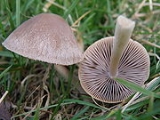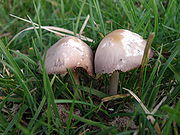
Conocybe rickenii
Encyclopedia
Conocybe rickenii is a mushroom from the genus Conocybe
. Its edibility is disputed, and it has the appearance of a typical little brown mushroom with a small, conical cap, and long, thin stem. In colour, it is generally a cream-brown, lighter on the stem, and it has a thin layer of flesh with no distinct smell or taste. It is a coprophilous fungi
, feeding off dung, and it is most common on very rich soil or growing directly from dung. It can be found in Europe, Australia and Pacific islands.
and named Galera rickenii. It was reclassified by Robert Kühner, who placed it in the Conocybe genus.
It is generally a little larger than the slightly more common coprophilious C. pubescens, while it can be differentiated from other dung-loving Conocybe by its two-spored basidia, large spores and the fact it does not have lecythiform caulocystidia.
 C. rickenii grows on extremely rich soil, especially on dung
C. rickenii grows on extremely rich soil, especially on dung
and compost heaps. It can be found in very large numbers in gardens where horse manure has been used to enrich the soil. It can be found in Europe
, Australia
, and Pacific islands
and the United States
.
Conocybe
The genus Conocybe is a genus of mushrooms consisting of Conocybe tenera and at least 243 other species, with at least 50 species in North America....
. Its edibility is disputed, and it has the appearance of a typical little brown mushroom with a small, conical cap, and long, thin stem. In colour, it is generally a cream-brown, lighter on the stem, and it has a thin layer of flesh with no distinct smell or taste. It is a coprophilous fungi
Coprophilous fungi
Coprophilous fungi are a type of saprobic fungi that grow on animal dung. The hardy spores of coprophilous species are unwittingly consumed by herbivores from vegetation, and are excreted along with the plant matter...
, feeding off dung, and it is most common on very rich soil or growing directly from dung. It can be found in Europe, Australia and Pacific islands.
Taxonomy
C. rickenii was first described by Jacob Christian SchäfferJacob Christian Schäffer
Jakob or Jacob Christian Gottlieb Schäffer or Schäffern was a German dean, professor, botanist, mycologist, entomologist, ornithologist and inventor.-Biography:...
and named Galera rickenii. It was reclassified by Robert Kühner, who placed it in the Conocybe genus.
Description
C. rickenii has a conical cap of 1 to 2.5 cm (0.393700787401575 to 0.984251968503937 in) across, which is an ochre-brown, sometimes becoming a little more grey at the centre. The stem is typically 40 to 70 mm (1.6 to 2.8 in) in height, by 1 to 2 mm (0.0393700787401575 to 0.078740157480315 in) in thickness, and is whitish cream, darkening to a dirty brown with age. The thin layer of flesh is grey-brown in the cap, while lighter in the stem. It has ochre-cream (later darkening to rusty-ochre) gills, which are adnate, leaving a brown spore print. The spores themselves are elliptic to oval, measuring between 10 um by 6 um. It has two-spored basidia, and a cellular cap cuticle.It is generally a little larger than the slightly more common coprophilious C. pubescens, while it can be differentiated from other dung-loving Conocybe by its two-spored basidia, large spores and the fact it does not have lecythiform caulocystidia.
Edibility
British mycologist Roger Phillips lists the edibility as unknown, while David Pegler considers it inedible. The flesh has no distinct smell or taste.Distribution and habitat

Feces
Feces, faeces, or fæces is a waste product from an animal's digestive tract expelled through the anus or cloaca during defecation.-Etymology:...
and compost heaps. It can be found in very large numbers in gardens where horse manure has been used to enrich the soil. It can be found in Europe
Europe
Europe is, by convention, one of the world's seven continents. Comprising the westernmost peninsula of Eurasia, Europe is generally 'divided' from Asia to its east by the watershed divides of the Ural and Caucasus Mountains, the Ural River, the Caspian and Black Seas, and the waterways connecting...
, Australia
Australia
Australia , officially the Commonwealth of Australia, is a country in the Southern Hemisphere comprising the mainland of the Australian continent, the island of Tasmania, and numerous smaller islands in the Indian and Pacific Oceans. It is the world's sixth-largest country by total area...
, and Pacific islands
Pacific Islands
The Pacific Islands comprise 20,000 to 30,000 islands in the Pacific Ocean. The islands are also sometimes collectively called Oceania, although Oceania is sometimes defined as also including Australasia and the Malay Archipelago....
and the United States
United States
The United States of America is a federal constitutional republic comprising fifty states and a federal district...
.

